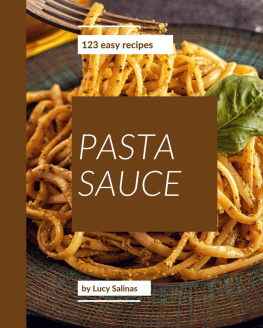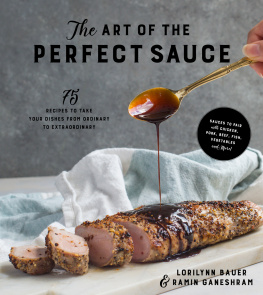THE HARVARD COMMON PRESS
535 Albany Street
Boston, Massachusetts 02118
www.harvardcommonpress.com
Copyright 2010 by Lucy Vaserfirer
All rights reserved. No part of this publication may be reproduced or transmitted in any form
or by any means, electronic or mechanical, including photocopying, recording, or any information
storage or retrieval system, without permission in writing from the publisher.
Printed in the United States of America
Printed on acid-free paper
Library of Congress Cataloging-in-Publication Data
Vaserfirer, Lucy.
Seared to perfection : the simple art of sealing in flavor / Lucy Vaserfirer.
p. cm.
Includes index.
ISBN 978-1-55832-398-8 (alk. paper)
1. Sauting. 2. Cookery (Meat) I. Title.
TX689.4.V37 2009
641.7'7dc22
2009050011
Special bulk-order discounts are available on this and other Harvard Common Press books.
Companies and organizations may purchase books for premiums or resale, or may arrange a
custom edition, by contacting the Marketing Director at the address above.
Jacket photographsfront: Rib-eye Steaks with Caramelized Onions, ;
spine: Pork Chops with Brandy-Mustard Cream Sauce, ; back: Pineapple with Vanilla Ice Cream
and Coconut-Caramel Sauce,
Jacket photographs by Joyce Oudkerk Pool
Food and prop styling by Heidi Gitner
Book design by Ralph Fowler Design
2 4 6 8 10 9 7 5 3 1
Acknowledgments
I extend a warm thank-you to Janie Hibler for her support and advice. Janie's kind words of encouragement convinced me to stop dreaming about this book and actually write it.
Thanks to Kathy Block-Brown, Bekki Callaway, Erin Keplinger, Sarah Keplinger, Cosh Ng, and Ian and Heather Penny for testing recipes and giving lots of thoughtful feedback.
Thank you to my brother, Andrew, for testing recipes and proofreading the text, and for being my biggest fan.
I'm so lucky to have my husband, Barry, who through it all believes in me. He's always the first person to lay eyes on any of my writing and to taste all of my recipe tests, and he gives me his honest opinion (even if it's slightly biased). He also functions as my kitchen assistant; all of the cooking times in the book are accurate thanks to his careful timekeeping.
I am ever grateful to my agent, Clare Pelino, for her patience, guidance, and support through this very long process.
And a big thank-you to my editor, Harriet Bell, from whom I learned so much. I am a stronger and more confident writer thanks to her.
Finally, my sincere thanks to Bruce Shaw, Jane Dornbusch, Valerie Cimino, and everyone else at The Harvard Common Press for embracing my idea and making this book a reality.
Introduction
That deep golden brown, slightly crisp surface and succulent, tender interior are the qualities of a perfectly cooked steak, chop, chicken breast, or fish fillet at a fine restaurant. How do they do it? You try at home, but the flavors just aren't as rich, the textures not quite as appealing.
What do professional chefs know that you don't?
The answer is searing.
Searing is one of the reasons that restaurant food and home cooking seem worlds apart. Learn to sear, and you too can create restaurant-quality dishes in your home kitchen. You'll have the knowledge and skill to coax the maximum flavor from each morsel of food. And perhaps the best part is that searing requires very little time, very few ingredients, and very little effort to turn out very impressive dishes. In just 15 to 20 minutes, you can put together a restaurant-caliber meal if you understand proper searing technique. And that's what Seared to Perfection is all about.
I realized the need for this book when I was the director and chef at In Good Taste Cooking School in Portland, Oregon. I developed and taught a popular class called Searing Mastery. But to my surprise, when I looked for a book to recommend to my students for further reading, I found nothing. I knew home cooks needed and wanted more information, and my idea for Seared to Perfection grew from there.
Learning to sear is a must for meat and seafood lovers. You don't need to go to an expensive restaurant to enjoy a tender and juicy steak, chop, or fillet, and you will actually be able to achieve better results at home for a fraction of the cost.
Searing is also ideal for today's busy home cooks. It's the technique to keep in mind when you find yourself in the grocery store at 6:00 p.m., after work, wondering, "What's for dinner?" With its short prep and cooking times, searing is a quick, easy solution and satisfying answer.
Finally, if you consider yourself a foodie, a gourmet, or a sophisticated cook, or you simply love to entertain, knowing how to sear properly will take your cooking to the next level, allowing you to create restaurant-style dishes at home and cook spontaneously without a recipe.
What Is Searing?
Searing is a dry, high-heat cooking method. The result is food with a flavorful brown crust and tender interior. Searing is an ideal technique for cooking relatively thick and naturally tender foods. Beef, pork, lamb, chicken, duck, and seafood can all be seared with delectable results. Searing is also an interesting and unusual cooking method for tofu and a variety of firm fruits and vegetables. It's quick and easy; typically a food can be seared in less than five minutes per side.
The crispy crust on a properly seared food results from what is known as the Maillard browning reaction. That means when food is cooked at temperatures well above the boiling point of water, the proteins and sugars on the surface brown, and the flavors become rich and complex. Think of caramelizing sugar. White sugar is odorless and just tastes sweet, but when cooked into a caramel, it turns brown and the flavor, texture, and aroma change dramatically. The flavor of well-seared foods can be described as rich, full, savory, and satisfying.
The heat from cooking causes proteins to contract, squeezing out their juices. It has long been believed that searing "seals" in these juices, but if you watch the surface of any food as it sears, you will see that this is not true. Take a sea scallop, for example. After it hits the hot pan, moisture begins to glisten on its surface. As it continues to cook and goes from medium-rare to medium, the juices begin to pool on the surface. In fact, if the scallop is left in the pan long enough to become well-done, so much liquid is forced out that the scallop begins to simmer in its own juicesat this point it is no longer searing. So although it is true that properly seared foods are very juicy and succulent, searing does not actually seal their surface. Seared foods are moist because they are usually served medium-rare or medium. Overcooking is what forces out juices and makes things taste dry.
Most professional chefs consider searing to be the most important cooking method because not only does it produce a delectable finished dish, but it is also the foundation of other important cooking methods. Searing is always the first step of braising and often the first step of roasting and sauce making. Searing creates rich and complex flavors that these other techniques build upon. For the best results, chunks of meat must be seared before being simmered for soup or stew, and roasts should be seared before being popped into the oven. Even for something as simple as spaghetti sauce, the ground beef and sausage are first seared until brown.
Although searing is a critical step when braising, this book is devoted solely to searing. My goals are to demonstrate that searing can stand alone as a cooking method and that it's quick and easy to do at home.
It's no accident that so many recipes instruct cooks to sear an item as the first step. The purpose is to build flavor, not obliterate any trace of pink in the food. But all too often, home cooks don't actually brown anything; they "gray" it instead! "Grayed" food looks and tastes as bland as it sounds. Knowing how to sear properly will make the dishes you cook more delicious and more flavorful, just as in the finest restaurants.
Next page











